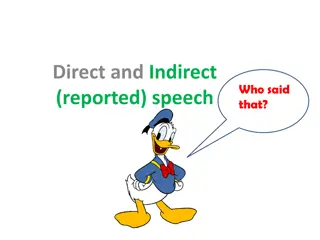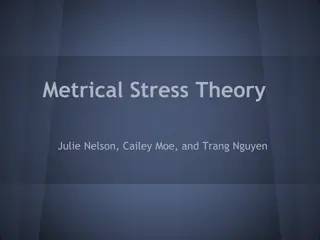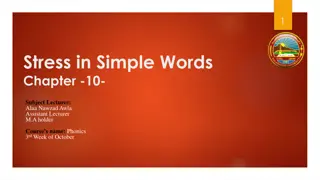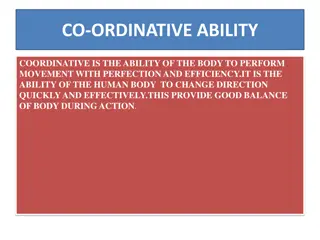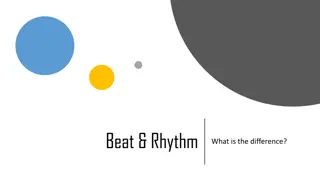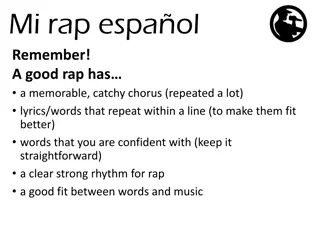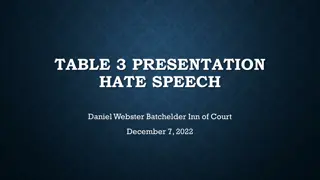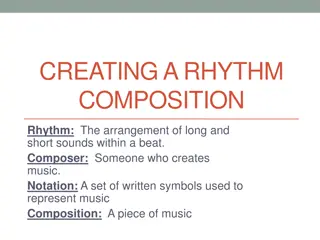Understanding English Rhythm and Stress Patterns in Speech
Delve into the nuances of English rhythm and stress patterns in speech with a focus on word stress, phrase stress, and the principle of eurhythmy. Explore how stress is influenced by volume, pitch, and duration of syllables in monosyllabic, disyllabic, trisyllabic, and polysyllabic words, with emphasis on pitch accent and stress structures.
Download Presentation

Please find below an Image/Link to download the presentation.
The content on the website is provided AS IS for your information and personal use only. It may not be sold, licensed, or shared on other websites without obtaining consent from the author. Download presentation by click this link. If you encounter any issues during the download, it is possible that the publisher has removed the file from their server.
E N D
Presentation Transcript
Topics in Phonetics & Phonology John Corbett: USP-CAPES International Fellow Session 11: The Rhythm of Everyday Speech
1. Introduction: Review of IPA & lexical sets 2. Review: Transcribing connected speech 3. Accents of English 1: Reference accents (RP and GenAm) Course structure 4. Revisiting English as a lingua franca 5. Accents of English 2: American accents 6. Accents of English 3: British Accents 7. Accents of English 4: Accents of World English 8. Accents of English 5: Brazilian English accents
9. Acoustic phonetics: Using WASP 10. Rhythms of English: Poetic metre 11. Rhythms of English: Rhythm in speech Course structure 12. Discourse intonation 1 13. Discourse intonation 2 14. Course review
English rhythm is based on the idea that certain syllables are spoken with greater energy (stress), volume, duration and a higher pitch. Poetry manipulates relatively stressed and unstressed syllables into regular patterns (called metrical patterns) Iamb x / trochee / x Anapaest x x / spondee / / Last week s session dactyl / x x pyrrhic foot x x In performance, rhythms can depart from the metrical rule by allowing substitute feet Rhythmic performance is aesthetically pleasing, heightened, and memorable.
The rhythm of everyday speech: Word stress Phrase stress Principle of eurhythmy Paralanguage Today s session
Stress involves an interaction between volume, pitch and duration of a syllable. Monosyllable give Word stress Disyllable forgive Trisyllable forgiveness Polysyllabic incandescent, supercalifragilisticexpialidocious
Possible 3-part stress structure of polysyllabic words Pitch accent P Level 1 Primary stress x Level 2 secondary stress x x Word stress Level 1 syllable x x x x in can de scent The pitch accent is where there is the movement of tone.
Possible 3-part stress structure of polysyllabic words Pitch accent P Word stress Level 1 Primary stress x Level 2 secondary stress x x x x x x x Level 1 syllable x x xx x xx x x x xx x x supercalifragilisticexpialidocious
English inherits from the Germanic languages a basic trochaic pattern with the possibility of an unstressed prefix: give giving forgiving Patterns of word stress This pattern hold for many frequently-used words. get/beget brother, sister, mother, father
English inherits from the Romance languages a more complex set of patterns depending on: Number of syllables in the word Part of speech Vowel duration in Latin Whether or not the word ends in a consonant Patterns of word stress benefit subject (n) beneficiary subject (verb) subdue
For Romance borrowings, the date at which a word enters English also has an impact on stress pattern: Word stress claret merlot
For Romance borrowings, the date at which a word enters English also has an impact on the word stress pattern: claret merlot late ME borrowing from French more recent borrowing Word stress Earlier borrowing adopts native Germanic stress pattern. How do you pronounce my name (Corbett)?
A compound (as a single word) will carry only one primary stress. A phrase (as a group of words) will carry more than one primary stress. Examples: Stress patterns in compunds Compound Phrase EXCEPTION to the rule: adjectives: compound adjectives may carry more than one primary stress: d ty-fr e; ch ld-pr of. st newall st ne w ll s feguard s fe gu rd br akdown br ak d wn
Any combination of parts of speech seems to be possible to produce compounds. The word class of the compound tends to be determined by the head of the compound (its right- most constituent), but its stress is usually carried by its left-most constituent e.g. babysit (v). Exceptions are phrasal verbs where the particle has most stress: take off, come over. The syntax of compounds
In English, the words are arranged syntactically in phrases in such a way as there is the perception (at least) of the most salient stressed syllables occurring at regular intervals. This regularity has been hard to capture acoustically but there does seem to be a perception of regularity. Stress in longer stretches of speech Look at the excerpt from Pulp Fiction on the following slide. In pairs, take it in turns to read the parts of Vincent and Jules. Underline the words that have PRIMARY STRESS in each utterance, that is, on the words that have a PITCH ACCENT. Roughly how many syllables separate the primary stresses?
VINCENT: What's her name? JULES: Mia. VINCENT: How did Marsellus and her meet? JULES: I dunno, however people meet people. She usta be an actress. From Pulp Fiction, by Quentin Tarantino VINCENT: She ever do anything I woulda saw? JULES: I think her biggest deal was she starred in a pilot. VINCENT: What's a pilot? JULES: Well, you know the shows on TV? VINCENT I don't watch TV. JULES: Yes, but you're aware that there's an invention called television, and on that invention they show shows? https://www.youtube.com/ watch?v=vEnpT8UiV_w VINCENT: Yeah. JULES: Well, the way they pick the shows on TV is they make one show, and that show's called a pilot. And they show that one show to the people who pick the shows, and on the strength of that one show, they decide if they want to make more shows. Some get accepted and become TV programs, and some don t, and become nothing. She starred in one of the ones that became nothing.
Phrasal stress rules typically conspire to achieve a particular rhythmic target. In general terms, the rules tend to create output configurations in which stresses are spaced not too far apart. A grid having these properties is said to be eurythmic; one can also speak of degrees of eurhythmy. The principle of eurhythmy -- Hayes, B. (1995) Metrical stress theory. Chicago: University of Chicago Press, p.372
Does California have the same stress pattern when you pronounce it in the following utterances? The principle of eurythmy Where do you live? California. Sing along! California dreaming On such a winter s day
Does the United States have the same stress pattern when you pronounce it in the following utterances? (Especially if you utter them as a sequence ) 1. We are looking at trade patterns between China and the United States. The principle of eurythmy 2. Companies in the United States are keen to develop the China connection. 3. And if you are in the United States trying to make a deal with China, then you have to take culture into consideration.
Does the United States have the same stress pattern when you pronounce it in the following utterances? (Especially if you utter them as a sequence ) 1. We are looking at trade patterns between China and the United States. The principle of eurythmy 2. Companies in the United States are keen to develop the China connection. 3. And if you are in the United States trying to make a deal with China, then you have to take culture into consideration. Arguably, in the third sentence you might shift the stress from States to United to avoid a clash of stresses on States trying
And they show that one show to the people who pick the shows and on the strength of that one show they decide if they want to make more shows. Eurythmy: in the mind?
Our voice quality and style of speaking also communicates particular messages and emotional affect. Factors of paralanguage include: Extremely high or low pitch on stressed syllables Elongation of syllables Pauses Volume (loud or quiet) Voice quality (e.g. creaky voice) Sound effects (whistle, imitation of a particular sound) Laughter Tempo of delivery (fast/slow) Facial gestures, body language, gaze Paralanguage These features can be coded.
M642 So, we're going by, and I go, "Hey, there they are", so I go 'Toot toot' on my horn, wave, and we then go on to the hump-back bridge. So, I give another wave as I'm going over the bridge. How would you use paralanguage to dramatise this conversational story? M608 [laugh] M642 John's gone ahead of me. And I've slowed down, because I'm thinking, "might go back and have a a wee hello", M608 mmhm M642 talk with them, [inhale]. Now, I'm up there and I'm just on the top, and I wave, and I'm down to no revs. The bike stalls. So you think, the bridge parapet, you okay with that? The, the [wall] F643 mmhm sure. M642 is that high: I'm there on the bike. I am waving like this, with one hand still on the throttle. Really r- low revs going over the hump. I g- open the throttle again, and the bike dies on me. https://www.scottishcorpus.ac.uk/document/?documentid=353
1. Rhythm is created by the sequencing of relatively stressed and relatively unstressed syllables. 2. Rhythm interacts with syntax to organise utterances. Take home messages 3. English prefers alternating stressed and unstressed syllables with the stresses roughly spaced in time. 4. We alter word and phrase stress in some cases to preserve an alternation of unstressed and stressed syllables (eurythmy). 5. Rhythm and other features of paralanguage convey affect and style.
Next week Intonation in English



